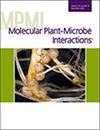Diana Gómez De La Cruz, Darwin A Castillo, César A Trujillo B, Cesar A Medina, Valentina Hurtado-McCormick, Juliana Gil, Meenu Padmanabhan, Silvia Restrepo, Savithramma P Dinesh-Kumar, Hugo Germain, Camilo López, Adriana Bernal
求助PDF
{"title":"相黄单胞菌XopAE效应物。manihotis靶向hsp20样p23 Cochaperone抑制植物基础免疫","authors":"Diana Gómez De La Cruz, Darwin A Castillo, César A Trujillo B, Cesar A Medina, Valentina Hurtado-McCormick, Juliana Gil, Meenu Padmanabhan, Silvia Restrepo, Savithramma P Dinesh-Kumar, Hugo Germain, Camilo López, Adriana Bernal","doi":"10.1094/MPMI-08-24-0086-R","DOIUrl":null,"url":null,"abstract":"<p><p>Pathogenic bacteria use Type 3 effector proteins to manipulate host defenses and alter metabolism to favor their survival and spread. The non-model bacterial pathogen <i>Xanthomonas phaseoli</i> pv. <i>manihotis</i> (<i>Xpm</i>) causes devastating disease in cassava. The molecular role of Type 3 effector proteins from <i>Xpm</i> in causing disease is largely unknown. Here, we report that the XopAE effector from <i>Xpm</i> suppresses plant defense responses. Our results show that XopAE is a suppressor of basal defenses such as callose deposition and the production of reactive oxygen species. XopAE targets a small heat shock protein (<i>Me</i>p23-1 cochaperone) in cassava and its homolog <i>At</i>p23-1 in <i>Arabidopsis</i>. XopAE localizes to the nucleus and in scattered points throughout the cell border, whereas <i>Me</i>p23-1 shows a nucleocytoplasmic localization. Upon interaction, XopAE hijacks <i>Me</i>p23-1 to the scattered points throughout the cell border, and they also interact in the nucleus. Our results indicate that the interaction between XopAE and <i>Me</i>p23-1 is essential for suppressing basal plant defense. This study is one of the first to address the molecular mechanisms deployed by <i>Xpm</i> to cause disease in cassava, a non-model crop plant. [Formula: see text] Copyright © 2025 The Author(s). This is an open access article distributed under the CC BY-NC-ND 4.0 International license.</p>","PeriodicalId":19009,"journal":{"name":"Molecular Plant-microbe Interactions","volume":" ","pages":"365-375"},"PeriodicalIF":3.4000,"publicationDate":"2025-05-01","publicationTypes":"Journal Article","fieldsOfStudy":null,"isOpenAccess":false,"openAccessPdf":"","citationCount":"0","resultStr":"{\"title\":\"The XopAE Effector from <i>Xanthomonas phaseoli</i> pv. <i>manihotis</i> Targets HSP20-like p23 Cochaperone to Suppress Plant Basal Immunity.\",\"authors\":\"Diana Gómez De La Cruz, Darwin A Castillo, César A Trujillo B, Cesar A Medina, Valentina Hurtado-McCormick, Juliana Gil, Meenu Padmanabhan, Silvia Restrepo, Savithramma P Dinesh-Kumar, Hugo Germain, Camilo López, Adriana Bernal\",\"doi\":\"10.1094/MPMI-08-24-0086-R\",\"DOIUrl\":null,\"url\":null,\"abstract\":\"<p><p>Pathogenic bacteria use Type 3 effector proteins to manipulate host defenses and alter metabolism to favor their survival and spread. The non-model bacterial pathogen <i>Xanthomonas phaseoli</i> pv. <i>manihotis</i> (<i>Xpm</i>) causes devastating disease in cassava. The molecular role of Type 3 effector proteins from <i>Xpm</i> in causing disease is largely unknown. Here, we report that the XopAE effector from <i>Xpm</i> suppresses plant defense responses. Our results show that XopAE is a suppressor of basal defenses such as callose deposition and the production of reactive oxygen species. XopAE targets a small heat shock protein (<i>Me</i>p23-1 cochaperone) in cassava and its homolog <i>At</i>p23-1 in <i>Arabidopsis</i>. XopAE localizes to the nucleus and in scattered points throughout the cell border, whereas <i>Me</i>p23-1 shows a nucleocytoplasmic localization. Upon interaction, XopAE hijacks <i>Me</i>p23-1 to the scattered points throughout the cell border, and they also interact in the nucleus. Our results indicate that the interaction between XopAE and <i>Me</i>p23-1 is essential for suppressing basal plant defense. This study is one of the first to address the molecular mechanisms deployed by <i>Xpm</i> to cause disease in cassava, a non-model crop plant. [Formula: see text] Copyright © 2025 The Author(s). This is an open access article distributed under the CC BY-NC-ND 4.0 International license.</p>\",\"PeriodicalId\":19009,\"journal\":{\"name\":\"Molecular Plant-microbe Interactions\",\"volume\":\" \",\"pages\":\"365-375\"},\"PeriodicalIF\":3.4000,\"publicationDate\":\"2025-05-01\",\"publicationTypes\":\"Journal Article\",\"fieldsOfStudy\":null,\"isOpenAccess\":false,\"openAccessPdf\":\"\",\"citationCount\":\"0\",\"resultStr\":null,\"platform\":\"Semanticscholar\",\"paperid\":null,\"PeriodicalName\":\"Molecular Plant-microbe Interactions\",\"FirstCategoryId\":\"99\",\"ListUrlMain\":\"https://doi.org/10.1094/MPMI-08-24-0086-R\",\"RegionNum\":3,\"RegionCategory\":\"生物学\",\"ArticlePicture\":[],\"TitleCN\":null,\"AbstractTextCN\":null,\"PMCID\":null,\"EPubDate\":\"2025/6/5 0:00:00\",\"PubModel\":\"Epub\",\"JCR\":\"Q2\",\"JCRName\":\"BIOCHEMISTRY & MOLECULAR BIOLOGY\",\"Score\":null,\"Total\":0}","platform":"Semanticscholar","paperid":null,"PeriodicalName":"Molecular Plant-microbe Interactions","FirstCategoryId":"99","ListUrlMain":"https://doi.org/10.1094/MPMI-08-24-0086-R","RegionNum":3,"RegionCategory":"生物学","ArticlePicture":[],"TitleCN":null,"AbstractTextCN":null,"PMCID":null,"EPubDate":"2025/6/5 0:00:00","PubModel":"Epub","JCR":"Q2","JCRName":"BIOCHEMISTRY & MOLECULAR BIOLOGY","Score":null,"Total":0}
引用次数: 0
引用
批量引用

 求助内容:
求助内容: 应助结果提醒方式:
应助结果提醒方式:


